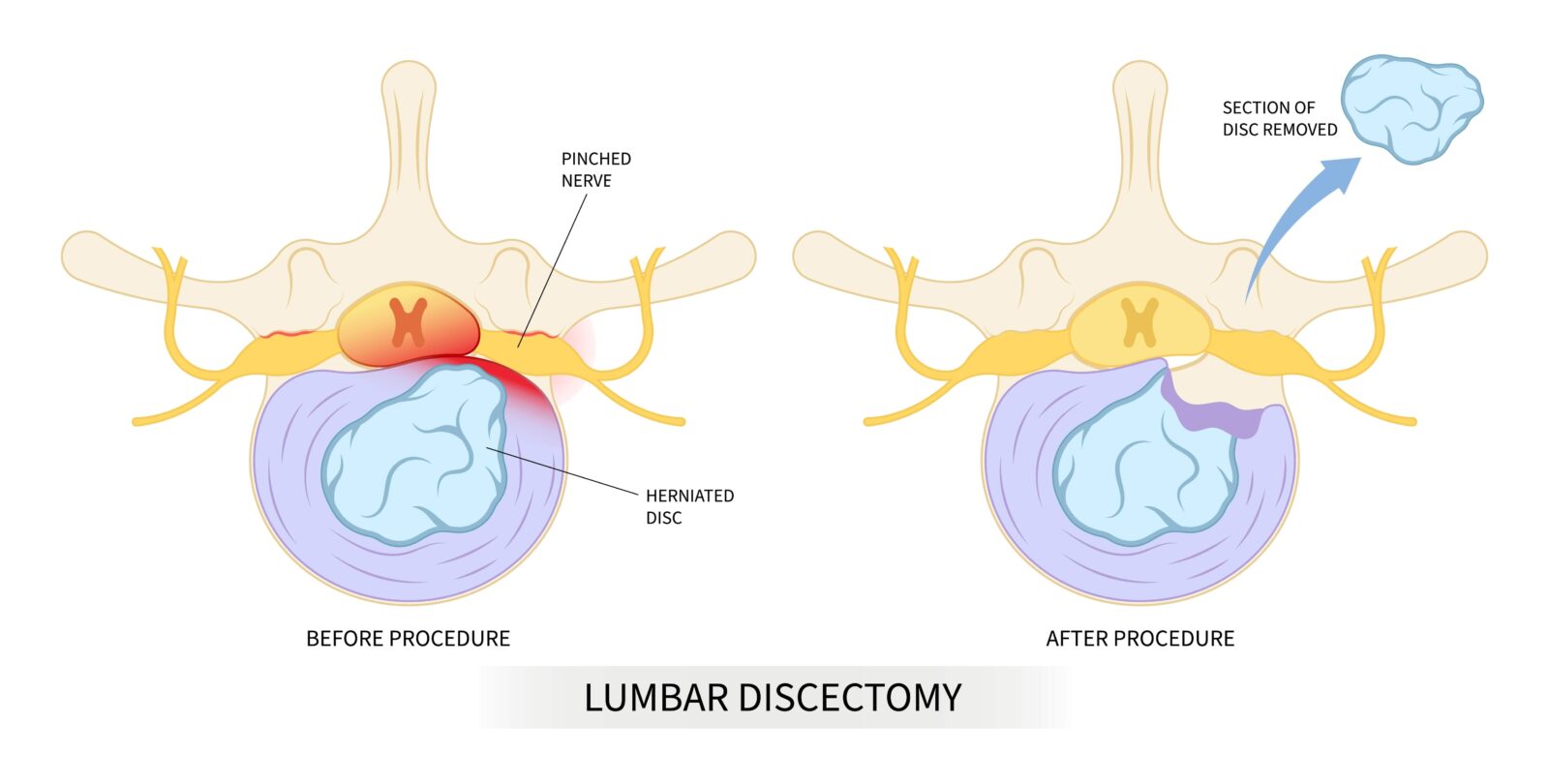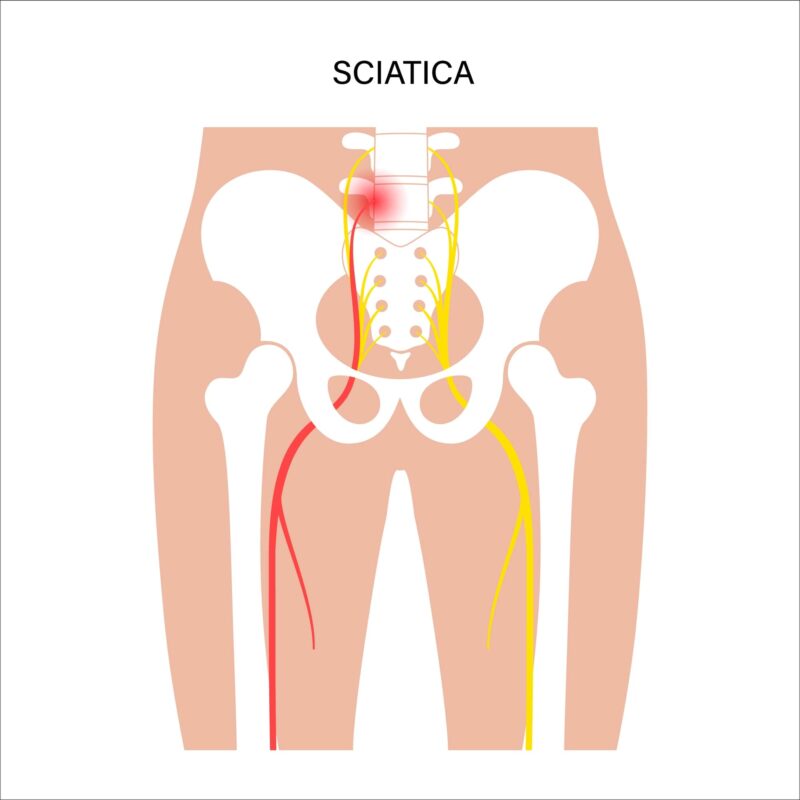Sciatica, characterized by pain that radiates along the path of the sciatic nerve, can significantly impact daily life. Originating in the lower back and extending through the hips and buttocks down each leg, sciatic pain often arises from nerve compression. Accurate diagnosis is crucial for effective treatment, as the underlying cause of sciatica can vary from herniated discs to spinal stenosis or muscle tension. While many immediately fear surgery, a multitude of non-surgical treatments offer relief and can effectively manage symptoms. This blog delves into these non-surgical options, detailing their benefits and practicalities, and also discusses the circumstances under which surgery might become a necessary consideration.
In This Blog:
- Non-Surgical Treatments for Sciatica
- When to Consider Surgery
- Types of Surgical Treatments
Non-Surgical Treatments for Sciatica
Sciatica can often be managed and relieved through various non-surgical methods. These treatments aim to alleviate pain, reduce inflammation, and improve mobility. Here’s a closer look at the non-surgical options for treating sciatica:
Physical Therapy
Physical therapy is a cornerstone of sciatica treatment. A physical therapist can design a personalized exercise program to strengthen the muscles supporting the spine, enhance flexibility, and improve posture. These exercises often focus on alleviating pressure on the sciatic nerve by correcting misalignments and building core strength, which can prevent future episodes of sciatica.
Medications
Over-the-counter pain relievers such as ibuprofen or acetaminophen can be effective in managing sciatica pain. In more severe cases, a doctor may prescribe stronger medications, including muscle relaxants or anti-inflammatory drugs, to reduce pain and swelling. It’s important to use these medications as directed and discuss any potential side effects with a healthcare provider.

Heat/Ice Therapy
Applying heat or ice to the affected area can provide immediate relief for sciatic pain. Ice packs can reduce inflammation and numb the area, alleviating acute pain, while heat therapy can relax muscle tension and improve blood circulation. Many find alternating between heat and ice offers the best relief.
Lifestyle Modifications
Making adjustments to daily activities can significantly impact the severity and frequency of sciatica symptoms. Ergonomic workplace setups, proper lifting techniques, and maintaining a healthy weight can prevent strain on the spine and nerves. Regular exercise, especially activities that promote flexibility and core strength, can also help prevent sciatica flare-ups.
Alternative Treatments
Some individuals find relief from sciatica through alternative treatments like acupuncture, chiropractic adjustments, or massage therapy. Acupuncture involves the insertion of thin needles into specific body points to relieve pain and improve function. Chiropractic care can help align the spine and reduce nerve irritation, while massage therapy can loosen tight muscles and increase blood flow to the affected area.
Overall, non-surgical treatments for sciatica are diverse and can be highly effective in managing and relieving pain. These methods, often used in combination, can help individuals return to normal activities with less discomfort and a reduced risk of recurrence. However, it’s essential to consult with healthcare professionals to determine the most appropriate treatment plan based on the individual’s specific condition and symptoms.
When to Consider Surgery for Sciatica
While non-surgical treatments are effective for many individuals with sciatica, surgery may be necessary in certain cases, especially when conservative measures fail to provide relief or when neurological symptoms worsen. Here are some situations where surgery might be considered:
Severe Symptoms and Lack of Improvement
If sciatica causes severe pain that persists or worsens over time, despite trying various non-surgical treatments, surgery might be the next step. This is particularly true if the pain is debilitating and significantly affects quality of life, including sleep, daily activities, and mobility.
Cauda Equina Syndrome
Surgery is urgent in cases of cauda equina syndrome, a rare but serious condition characterized by severe low back pain, loss of bladder or bowel control, and significant weakness or loss of sensation in the legs. This condition is a medical emergency and requires immediate surgical intervention to prevent permanent damage.
Other Conditions
Surgery may also be necessary for specific underlying causes of sciatica, such as a herniated disc or spinal stenosis, if these conditions lead to significant nerve compression and do not respond to conservative treatment. In these instances, the goal of surgery is to relieve pressure on the sciatic nerve and stabilize the spine.
Types of Surgical Treatments
Surgery for sciatica is generally considered a last resort, typically recommended only when non-surgical treatments have failed to provide adequate relief, or when the patient’s condition suggests a risk of permanent nerve damage. It’s crucial to have a thorough evaluation and discussion with a healthcare provider to weigh the benefits and risks of surgery based on individual circumstances and overall health. When surgery is recommended one of the following techniques is generally used:
Microdiscectomy

This is a common surgical procedure for sciatica resulting from a herniated disc. The surgeon removes a small portion of the disc to relieve nerve pressure. Microdiscectomy has a high success rate and is typically recommended when conservative treatments have not been effective after several weeks or months.
Laminectomy
In the case of spinal stenosis, a laminectomy may be performed. This procedure involves removing part of the vertebral bone (lamina) to open up the spinal canal and reduce pressure on the nerves. This can provide significant relief for patients with spinal stenosis who experience sciatic symptoms.
Recovery and Rehabilitation After Surgery for Sciatica
After undergoing surgery for sciatica, the recovery and rehabilitation process is crucial for regaining strength, flexibility, and function, and for preventing future episodes of back pain or sciatica. Here’s what typically involves in the post-operative phase:
Immediate Post-Surgery Recovery
The initial recovery period varies depending on the type of surgery performed. Patients may be encouraged to walk and move around within a few hours after surgery to promote blood flow and prevent blood clots. Pain management is a priority during this phase, and medication may be prescribed to alleviate discomfort.
Physical Rehabilitation
Rehabilitation often begins a few weeks after surgery, once the surgical site has begun to heal. A physical therapist will design a personalized rehabilitation program that gradually reintroduces activities and exercises to strengthen the back and abdominal muscles, improve flexibility, and enhance spinal health. This tailored approach helps ensure a safe and effective recovery.
Activity Modification
Patients are typically advised to avoid certain movements and activities that strain the back, such as lifting heavy objects, twisting, or bending abruptly, during the recovery period. Gradually, as healing progresses, individuals can start resuming more activities under the guidance of their healthcare provider.
Ongoing Support and Monitoring
Follow-up appointments are essential to monitor the healing process, evaluate the effectiveness of the surgery, and adjust the rehabilitation plan as needed. These check-ups help ensure that recovery is on track and allow for early intervention if any complications arise.
Long-Term Management
The ultimate goal of recovery is not just to alleviate the immediate symptoms of sciatica but also to implement long-term strategies to maintain spinal health and prevent recurrence. This includes regular exercise, maintaining a healthy weight, practicing good posture, and incorporating ergonomic adjustments in daily activities.
Conclusion
In conclusion, while sciatica can be a debilitating condition, there are numerous non-surgical treatments that effectively manage its symptoms and improve quality of life. These should always be the first line of approach, with surgery considered only when these methods fail or in cases of severe, progressive neurological deficit. Understanding the range of treatment options, from physical therapy and medications to potential surgical interventions, enables individuals to make informed decisions about their care. Consulting with healthcare professionals to tailor a treatment plan specific to one’s condition is essential. Ultimately, a proactive and informed approach to managing sciatica can lead to better health outcomes and a faster return to everyday activities.










